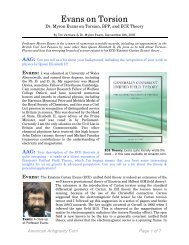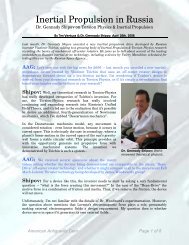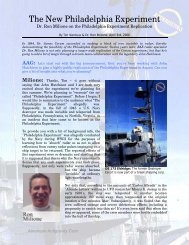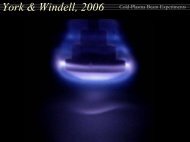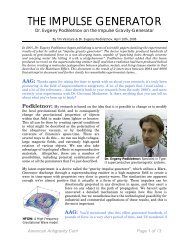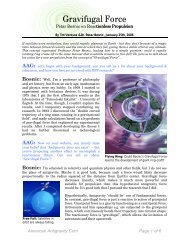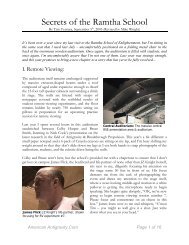JCE-Generator-Experi.. - American Antigravity
JCE-Generator-Experi.. - American Antigravity
JCE-Generator-Experi.. - American Antigravity
You also want an ePaper? Increase the reach of your titles
YUMPU automatically turns print PDFs into web optimized ePapers that Google loves.
Jeff Cook Device <strong>Experi</strong>mental ReviewBy Tim Ventura, Oct 16 th , 2003Overview<strong>American</strong> <strong>Antigravity</strong> conducted an 8-hour evaluation of the Jeff Cook Effect<strong>Generator</strong>, using a device constructed by Cook on loan to AAG for experimentaluse. Several noticeable effects were observable during testing: Firstly, the coildoes in fact have a slight but observable effect on flames, which provides supportfor Cook's claims regarding the device. Secondly, the device creates a large &pronounced magnetic field, which has a disruptive EMP effect on nearbyelectronics devices and exerts considerable force on magnets at up to severalfeet in distance.<strong>Experi</strong>mental Notes1. The Cook device produces a large magnetic field while operating, whichsuggests the possibility that the effect on the flame is magneto-plasma based. Inother words, 12% of normal flames are plasma, and a large pulsed magnetic fieldshould interact to some degree with this plasma.2. Disconnecting the Cook-coil while in operation creates a large, high-voltagepulse of electricity when the magnetic field collapses. This was interesting,because even with a 12-volt potential across the leads, the collapse of themagnetic field can create both large sparks and painful shocks (especially if youare holding the wires onto the battery by hand)!3. I believe that the frequency of my coil at 12-volts @~30/60 hz was not the bestoperating frequency (although resonant for the relay). I say this because theeffects on the flame that I noticed occurred to a larger degree when applying ordisconnecting power, despite the fact that the relay does this 30 or 60 times persecond during operation.4. The magnetic field of the Cook Device is large enough to have EMP effects onnearby electronics. In my experiments, this included interference with cameraoperation, and the destruction of the microcontroller in a kitchen-range whiletesting on the natural-gas burner.5. Neodynium Magnets used to trace the magnetic field of the Cook Deviceshowed the expected two-bubble field configuration, with field concentrationssurrounding the front and rear electromagnet assemblies. The front assembly iswound around a ferrous core and sandwiched between carbide-cutting disksused as coil-retaining endplates. The rear coil is smaller and wound around a
ferrous bolt. As expected, the magnetic field from the front coil is larger in size,and had a greater effect on the Nd magnets used to trace the field outline.Difficulty was encountered tracing the field using the Nd magnets at the front ofthe Cook device. The front consists of a carbide disk with a retaining bolt in thecenter to hold the disk in place. During operation, the front of the Cook devicehad a very non-uniform field, partially because the tracing magnets weresimultaneously attracted to the retaining bolt and repelled by the coil'selectromagnetic field.6. The Neodynium magnets were suspended in air from a 3-foot length of thread,and balanced to allow free rotation. Activation of the Cook device had a profoundeffect on the magnets, even up to 2.5 feet in distance from the coil. At closerange, the effects on the Nd magnets were either an intense attraction to the coil,or else a torsion effect that created spin in the magnets (depending on what endof the stack was pointing towards the device while it was operated).While this effect on the suspended magnets was within expectations, thefollowing was not: the magnets were removed after testing and hung on thestring several feet away from the coil. Operation of the coil for other experimentsstill created a strong attractive response in the hanging Nd magnets, even atseveral feet in distance.7. During experiments using a candle flame approximately 3 inches from thefront of the coil, sparks were noted to emanate from the candle and jump towardsthe coil intermittently during rapid pulsed activation of the coil. Bear in mind thatthe relay itself pulses the coil, so rapid manual pulses consist of perhaps 15cycles (1/2 second) of activity in the coil.Sparking did not occur in the candle other than during pulsed coil-activation, andeven then occurred perhaps only 30% of the time.8. Testing was conducted using 9, 12, and 24-volt batteries. The 9-volt battery asrecommended by Jeff Cook created no noticeable effects on either flames orferrous materials. This is presumed to be the result of the high internal-resistanceof 9-volt batteries, which generally make them unsuitable for high current-drawapplications.The resistance of the Cook coil is approximately 4 ohms, which allows amaximum current draw of 3 amps current with a steady 12-volt potential, or 6amps current with a steady 24-volt potential. Note that actual current draw isconsiderably lower than this due to the pulsed nature of the relay. Additionally,minor inductive reactance from rapid pulsing should further lower the actualcurrent draw of the device during pulsed operation.
While the 9-volt battery proved unworkable for powering the device despiteCook's claims, the effects did manifest themselves when larger 12 and 24-voltbatteries were tested.Power consumption on the Cook Effect device was below 36-watts at 12-volts,and below 144 watts at 24-volts. Again, due to the pulsed nature of the relay theactual power-usage should be considerably lower than these values.ConclusionsI believe that the effects observed by Jeff Cook are the result of high-amplitudemagnetic field pulses during the operation of the device. The effects of the coil onferrous materials are highly-repeatable and appear to be a direct result of thehigh-intensity magnetic field of the device.The effects of the Jeff Cook device on flames are more difficult to replicate, andthe transient nature of their appearance at the beginning and end of coilactivation leads me to believe that these are the result of both operatingfrequency and high-voltage back-EMF as the coil's magnetic field collapses.It is known that back-EMF from collapsing magnetic fields can create highvoltage,high-current pulses of electricity. I believe that these short-duration,high-intensity pulses of energy allow the coil to create very high-intensitymagnetic fields which are causing the effects on the candle flame. This wouldexplain the transient nature of the effect, because these short-duration pulseswould vary in magnitude depending on where in the device's operating cycle thecircuit is broken when manually pulsed. (In other words, the relay is normallypulsing the coil rapidly, but manually pulsing the coil interrupts this cycle atrandom intervals. Depending on where the cycle is when it is interrupted, theback-EMF pulse will differ in magnitude).One final thought: I did get the distinct impression that the Jeff Cook Effectdevice is a rather unique design and worthy of further examination. <strong>American</strong><strong>Antigravity</strong>'s investigation examined only the claims of Jeff Cook, and did not lookfurther to find other potentially unique effects created by this device. I believe thatfurther investigation may reveal more unique features about this device,especially with regard to high-intensity pulsed-power applications.



